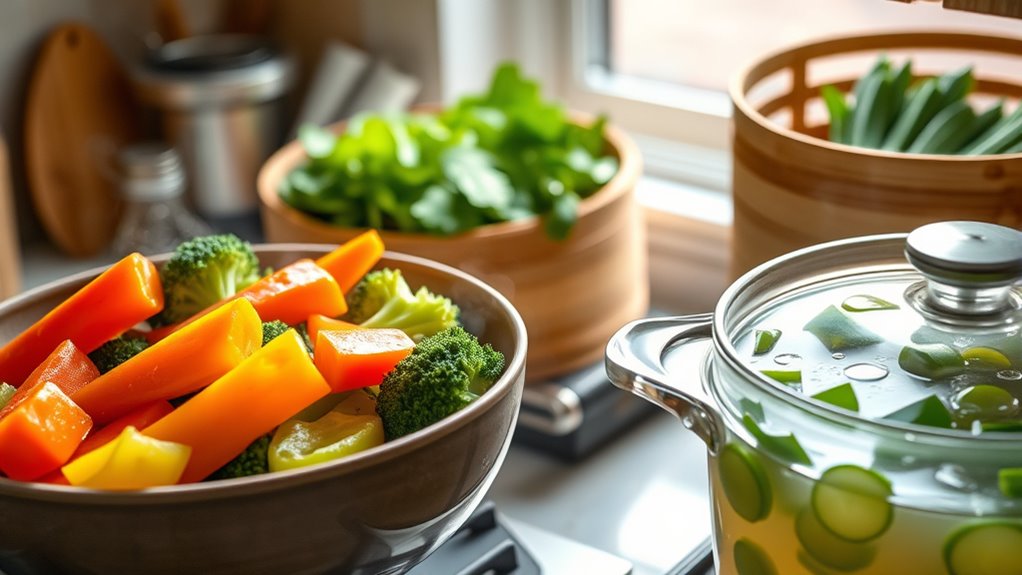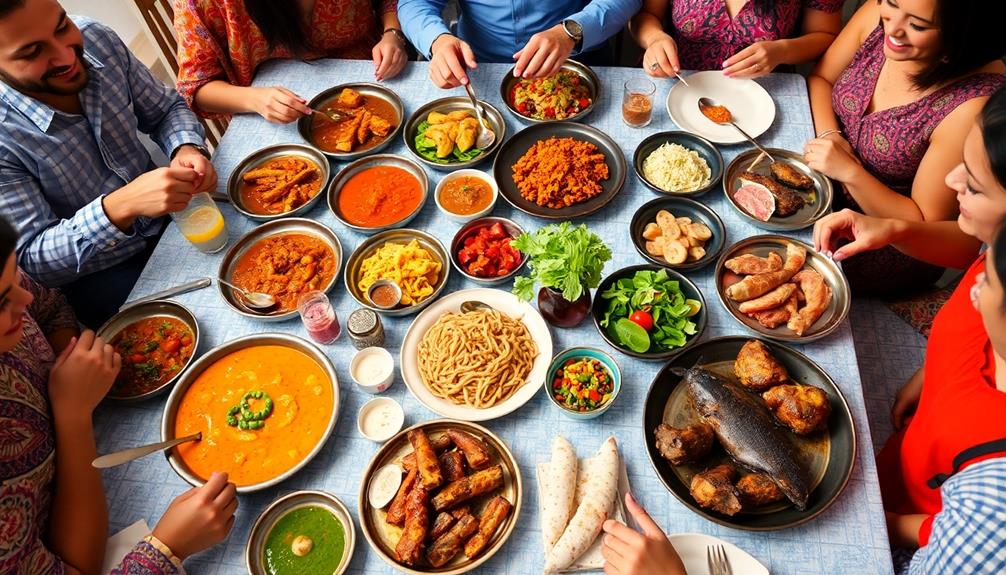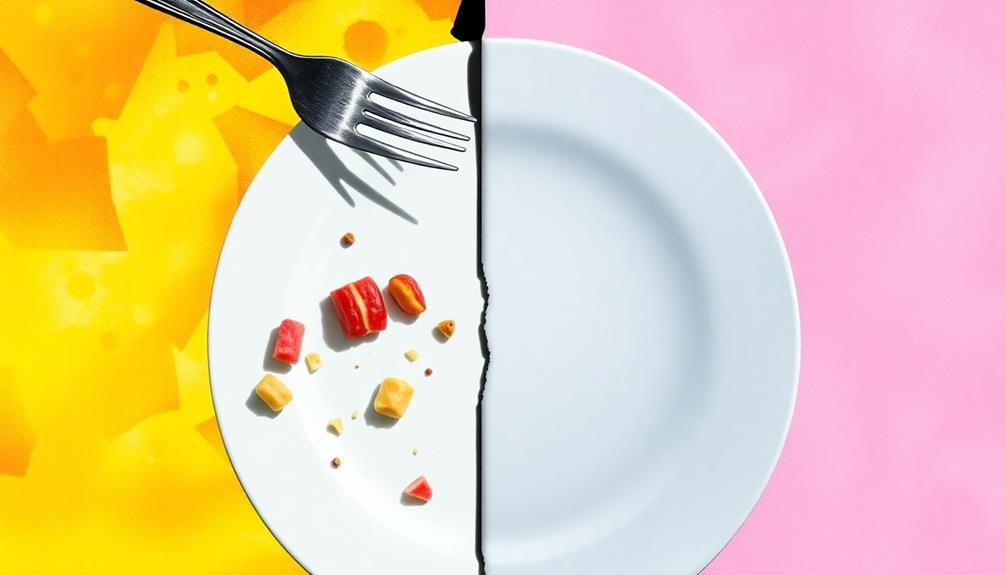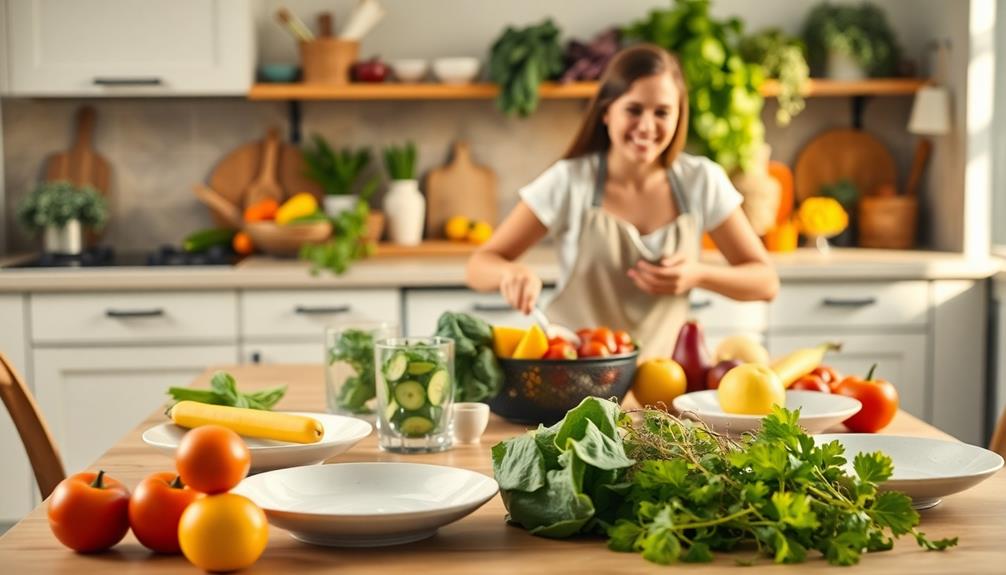To preserve nutrients, opt for gentle, quick methods like steaming, stir-frying, and microwaving, which minimize heat exposure and nutrient loss. Using techniques like sous vide allows precise temperature control, locking in nutrients and flavors. Careful boiling, blanching, and pressure cooking also help retain vitamins while reducing nutrient leaching. Incorporating raw or minimally cooked foods boosts nutrient intake. Keep exploring for more tips on maximizing your food’s nutritional value with every bite.
Key Takeaways
- Use gentle cooking methods like steaming and blanching to minimize nutrient loss and preserve natural flavors.
- Opt for quick techniques such as stir-frying and microwaving to retain vitamins and minerals.
- Control cooking times and temperatures carefully to prevent overcooking and nutrient degradation.
- Employ vacuum sealing and low-temperature methods like sous vide for optimal nutrient preservation.
- Minimize water contact during boiling and use minimal water to prevent leaching of water-soluble nutrients.
Steaming to Lock in Nutrients

Steaming is one of the best ways to preserve the nutrients in your vegetables and other foods. By cooking with steam, you maximize nutrient retention because it uses minimal water and short cooking times. This method prevents water-soluble vitamins, like vitamin C and B vitamins, from leaching out. Additionally, steaming enhances cooking efficiency since it heats foods evenly without requiring constant attention or stirring. Unlike boiling, which can cause nutrient loss, steaming keeps the food’s natural flavors and textures intact. It also supports color accuracy, helping maintain the vibrant appearance of your produce. It’s simple, quick, and effective, making it ideal for maintaining the nutritional value of your produce. Proper usage and ergonomics can further improve your cooking experience and safety. Incorporating smart kitchen appliances that monitor temperature and cooking time can help optimize nutrient preservation even further, especially when paired with appropriate cookware designed for steaming.
Sous Vide Cooking for Optimal Preservation
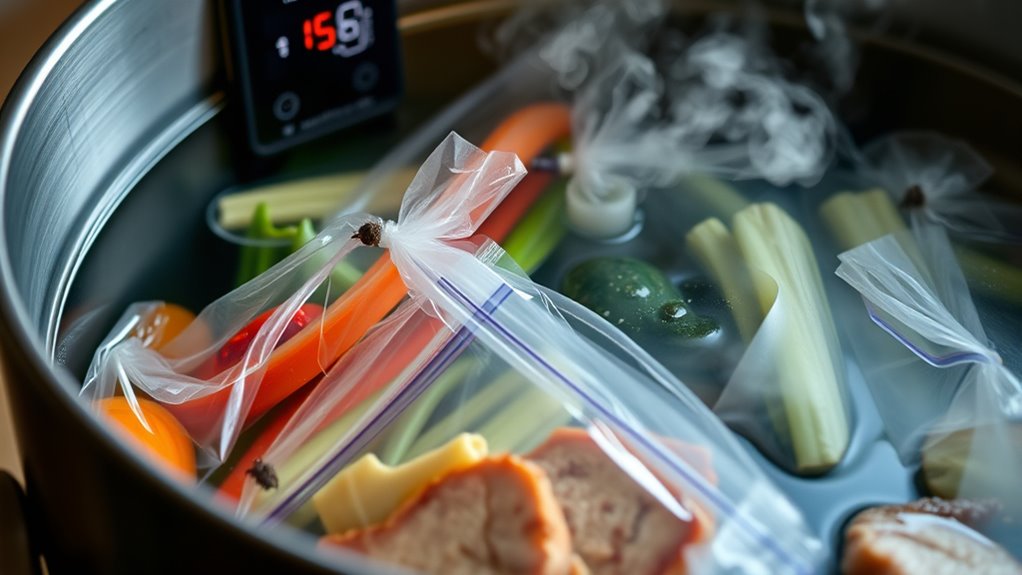
Because it allows precise control over temperature, sous vide cooking is one of the best methods for preserving nutrients. By maintaining a consistent, low temperature, you prevent overcooking and nutrient loss. Vacuum sealing your food removes air and prevents oxidation, which helps retain vitamins and minerals. This method ensures that delicate nutrients aren’t destroyed by high heat or prolonged cooking times. With sous vide, you can cook meats, vegetables, and even fruits to their ideal temperature, locking in flavor and nutrients without sacrificing texture. The controlled environment reduces nutrient degradation, making it a smart choice for health-conscious cooks. Overall, sous vide offers an efficient way to preserve the nutritional integrity of your ingredients while achieving perfect doneness every time.
Quick Stir-Fries to Minimize Nutrient Loss

Quick stir-fries are an excellent way to preserve nutrients because they cook ingredients rapidly at high heat, minimizing the time vitamins and minerals are exposed to heat and air. To maximize nutrient retention, focus on key steps:
Quick stir-fries preserve nutrients by cooking ingredients rapidly at high heat, locking in vitamins and minerals.
- Ingredient pairing: Combine quick-cooking vegetables like bell peppers, broccoli, and snap peas to ensure all ingredients cook evenly and retain their nutritional value.
- Minimal cooking time: Stir-fry for just a few minutes, keeping the vegetables vibrant and crisp, which helps conserve vitamins.
- Flavor enhancement: Use fresh garlic, ginger, and a splash of soy sauce to boost flavor without extra cooking time or nutrient loss.
Microwaving as a Quick and Nutrient-Friendly Method
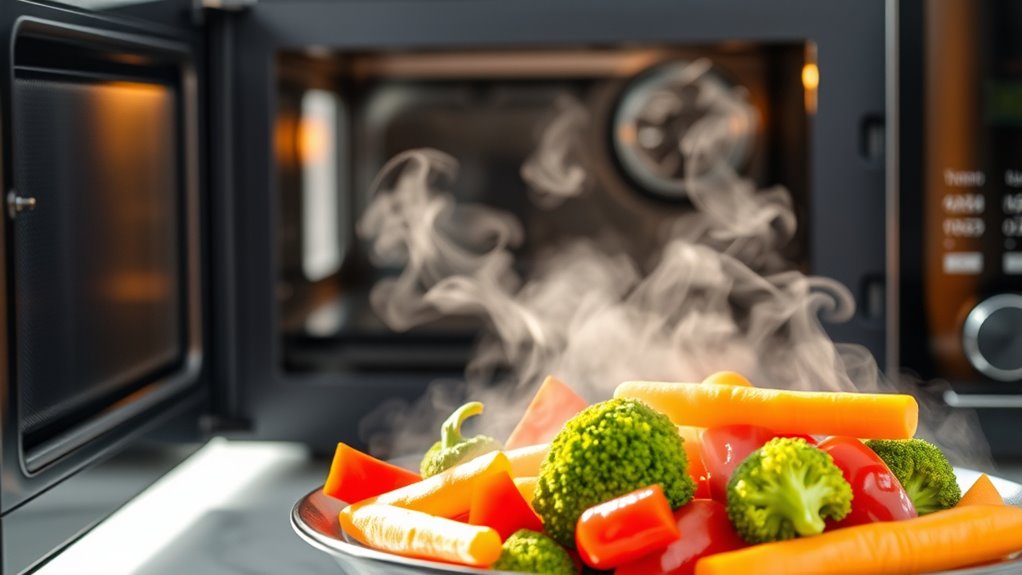
Microwaving is a fast way to cook your vegetables while keeping most of their nutrients intact. It uses minimal water and small amounts of food, which helps prevent nutrient loss. Plus, its speed and convenience make it an ideal choice for quick, healthy meals. Additionally, because microwaving can be easily monitored, it allows for better control of cooking conditions, further preserving nutrients.
Minimal Nutrient Loss
Have you ever wondered how to cook vegetables while keeping most of their nutrients intact? Microwaving is an excellent method for minimal nutrient loss because it uses short cooking times and little water. This helps preserve flavor enhancement and texture preservation. To maximize benefits, focus on these key points:
- Use minimal water to prevent nutrient leaching.
- Keep cooking times short to avoid breaking down vitamins.
- Cover vegetables to trap moisture and heat evenly.
- Regularly monitor and adjust settings to prevent overcooking sensor maintenance.
- Incorporating nutrient preservation techniques can further enhance the retention of vitamins during cooking.
- Selecting appropriate containers with microwave-safe materials can also help preserve nutrients and prevent contamination.
- Utilizing technology in modern appliances can optimize cooking processes for better nutrient retention.
Speed and Convenience
Because it requires only a short amount of time, microwaving is one of the fastest and most convenient ways to cook vegetables while preserving their nutrients. The quick process minimizes nutrient degradation that can occur with longer cooking methods, helping you retain more vitamins and minerals. Additionally, microwaving reduces flavor loss, keeping your vegetables tasting fresh and vibrant. Since you cook with minimal water and in a covered dish, nutrients aren’t leached out like they might be with boiling or steaming. This method is ideal when you need a quick, nutrient-friendly meal or snack. Its speed saves time without sacrificing the nutritional quality of your vegetables, making microwaving a smart choice for those prioritizing both convenience and health.
Uses Small Quantities
Using small quantities of food in the microwave enhances its efficiency and guarantees better nutrient retention. When you focus on portion control, you minimize cooking time, helping ingredients stay fresh and nutrient-rich. This method ensures that heat penetrates evenly, preserving ingredient freshness. Incorporating proper kitchen techniques can further improve nutrient preservation during microwave cooking.
Boiling With Care: Reducing Nutrient Leaching
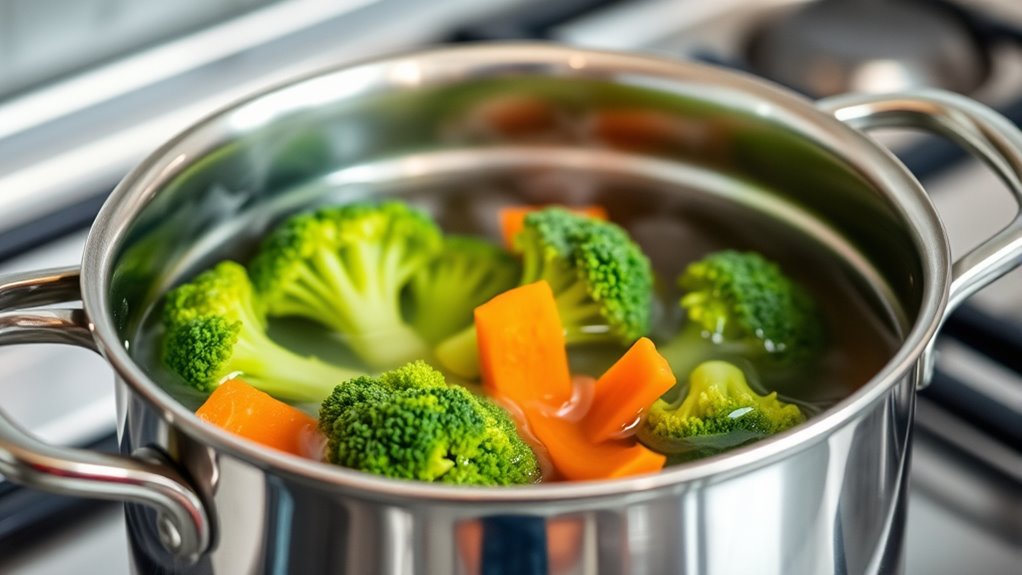
When boiling vegetables, use just enough water to cover them and keep the cooking time short. This helps prevent nutrients from leaching out into the water. By taking these simple steps, you can preserve more of the food’s nutritional value. Additionally, using appropriate cooking methods like steaming or microwaving can further minimize nutrient loss.
Use Minimal Water
To preserve nutrients during boiling, it is vital to use as little water as possible. This approach supports water conservation and helps retain flavor. First, use just enough water to cover your vegetables, minimizing leaching of vitamins and minerals. Second, consider steaming instead of boiling, which reduces water contact altogether. Third, if boiling is necessary, keep the lid on to trap heat and reduce the amount of water needed. These practices help limit nutrient loss by decreasing the amount of water in contact with your food. Additionally, less water means fewer nutrients are leached out, and flavors stay richer. Incorporating protective styling benefits such as covering your vegetables with a lid or steaming can further help preserve nutrients by limiting direct water contact. Using cooking techniques that minimize water use is an effective way to maintain the maximum nutritional value of your foods. For added preservation, choosing gentle heat methods can reduce nutrient degradation during cooking. By adopting minimal water use, you enhance both the nutritional quality and taste of your cooked foods.
Shorten Cooking Time
Reducing the cooking time can substantially help preserve nutrients in your vegetables. One way is to use microwave efficiency, which heats food quickly and evenly, minimizing nutrient loss. For stir-fry dishes, increasing your stir fry speed ensures vegetables are cooked just enough to retain their vitamins and minerals without overcooking. Avoid lengthy boiling sessions; instead, opt for shorter cooking methods like steaming or blanching, which cut down on nutrient leaching. When boiling, keep your water temperature lower and use a lid to speed up the process. By shortening cooking times, you prevent heat-sensitive nutrients from breaking down, ensuring your vegetables remain nutritious and vibrant. Quick, efficient cooking methods are your best choice for nutrient preservation.
Roasting and Baking to Maintain Food Quality

Roasting and baking are effective cooking methods for preserving nutrients because they use dry heat that minimizes water-soluble vitamin loss. These methods help retain food quality while preventing nutrient leaching. To maximize benefits, consider these tips:
Roasting and baking preserve nutrients by using dry heat that minimizes water-soluble vitamin loss.
- Use even heat to prevent nutrient degradation and ensure thorough cooking.
- Incorporate grilling techniques when roasting vegetables or meats to add flavor without nutrient loss.
- Explore fermentation processes before baking to boost probiotic content and enhance nutrient availability.
- Utilizing specific sound vibrations during cooking can influence cellular regeneration and overall food health benefits.
- Being aware of cooking methods that preserve nutrients can support healthier meal preparation and improve nutritional intake.
- Proper storage of ingredients before cooking can further maintain nutrient quality and reduce nutrient loss during the cooking process.
- Additionally, understanding the advances in food technology can help optimize cooking techniques to preserve maximum nutritional value.
Using Pressure Cooking for Faster and Healthier Results

Pressure cooking speeds up the cooking process while helping to preserve nutrients that can be lost through prolonged heat exposure. By cooking foods quickly under high pressure, you retain more vitamins and minerals compared to traditional methods. Pressure canning is also an excellent way to preserve seasonal produce, locking in nutrients and extending shelf life. When you use a pressure cooker, you reduce cooking time and minimize nutrient loss, making your meals healthier. This method is especially beneficial for tough vegetables, grains, and legumes, which cook faster and retain their flavor and nutritional value. Overall, pressure cooking allows you to prepare nutritious meals efficiently while maximizing nutrient retention, making it a smart choice for health-conscious cooks.
Blanching Techniques to Prepare Vegetables

Blanching is a quick and effective way to prepare vegetables for freezing, preserving their color, texture, and nutrients. When you blanch, you stop enzyme actions that cause spoilage, while maintaining vegetable texture and flavor enhancement. To do this properly:
- Bring a pot of water to a boil and prepare an ice bath.
- Submerge vegetables briefly, usually 30 seconds to a few minutes, depending on the vegetable.
- Quickly transfer vegetables to the ice bath to halt the cooking process.
Additionally, proper blanching can help preserve flavor and nutritional value, making your meals healthier and more delicious. Incorporating visual cues can also aid in determining the optimal blanching time for different vegetables. Understanding the nutrient retention process during blanching can further improve your food preservation techniques.
Incorporating Raw and Minimal-Cook Methods

Incorporating raw and minimal-cook methods into your cooking routine is an excellent way to maximize nutrient retention. When you eat foods raw or lightly prepared, you preserve delicate vitamins and minerals that can be destroyed by heat. These methods also enhance flavor, as natural tastes remain fresh and vibrant. Plus, minimal cooking helps preserve the texture of fruits and vegetables, offering a satisfying bite and appealing appearance. Using techniques like slicing, marinating, or quick steaming keeps nutrients intact while adding depth to your dishes. Additionally, understanding the importance of cooking methods can guide you in choosing the best way to retain nutrients. Incorporating proper food safety practices is essential when handling raw foods to prevent contamination. Being aware of nutrient loss during cooking can further inform your preparation choices, ensuring maximum health benefits. By choosing raw or lightly cooked options, you enjoy ideal health benefits without sacrificing taste or texture. This approach encourages a more mindful, nutrient-focused way of preparing your meals, making your diet both nutritious and delicious.
Frequently Asked Questions
Which Cooking Method Best Retains Vitamins in Leafy Greens?
When considering the best way to retain vitamins in leafy greens, you focus on cooking techniques that maximize nutrient retention. Steaming is highly effective because it uses minimal water and cooks quickly, preserving delicate vitamins. Stir-frying is also good, as it involves short cooking times and high heat, which helps retain nutrients. Avoid boiling, as it causes vitamins to leach into water. Choosing these methods guarantees you get the most nutritional value from your greens.
How Does Ph Level Affect Nutrient Preservation During Cooking?
Perfect pH balance plays a powerful part in preserving produce. When you cook in acidic environments, like adding lemon juice, the pH level becomes more acidic, which can help lock in nutrients and prevent nutrient loss. Conversely, alkaline conditions may lead to nutrient degradation. So, by controlling the pH level, you can maximize nutrient preservation, making your meals more nutritious and flavorful while maintaining the integrity of your ingredients.
Can Cooking Duration Impact Antioxidant Levels in Vegetables?
You might wonder if cooking duration impacts antioxidant levels in vegetables. Longer cooking can break down cell walls, releasing antioxidants, but overdoing it can lead to nutrient loss. Shorter cooking times often preserve more antioxidants, maintaining their health benefits. So, by controlling cooking duration, you can maximize antioxidant levels, ensuring you get the most nutritional value from your vegetables. Adjust your cooking time to balance flavor and nutrient preservation effectively.
Are There Specific Cookware Materials That Help Preserve Nutrients?
Imagine your nutrients fighting for survival—your choice of cookware can make all the difference! Ceramic cookware is a hero, locking in antioxidants and vitamins with its non-reactive surface. Stainless steel cookware also helps preserve nutrients because it doesn’t leach chemicals or heat unevenly. So, pick wisely; your health depends on it! Both options help keep your vegetables packed with essential nutrients, making every bite a powerful boost for your body.
Does Adding Water During Cooking Cause Nutrient Loss?
When you add water during cooking, it can cause nutrient loss through water leaching and nutrient leaching. Water-soluble vitamins like C and B vitamins tend to dissolve into the cooking water, reducing their levels in your food. To minimize this, use as little water as possible and consider steaming or microwaving, which help retain more nutrients by limiting water contact and leaching.
Conclusion
Think of your cooking methods as a garden’s gentle hand guiding delicate blooms. When you choose to steam, sous vide, or quick stir-fry, you’re nurturing your nutrients like tender care for fragile flowers. By respecting each method’s strengths, you preserve your food’s liveliness and flavor. Remember, your kitchen is your garden—treat it with mindfulness, and your meals will flourish with health and vigor, just like a well-tended garden in full bloom.

